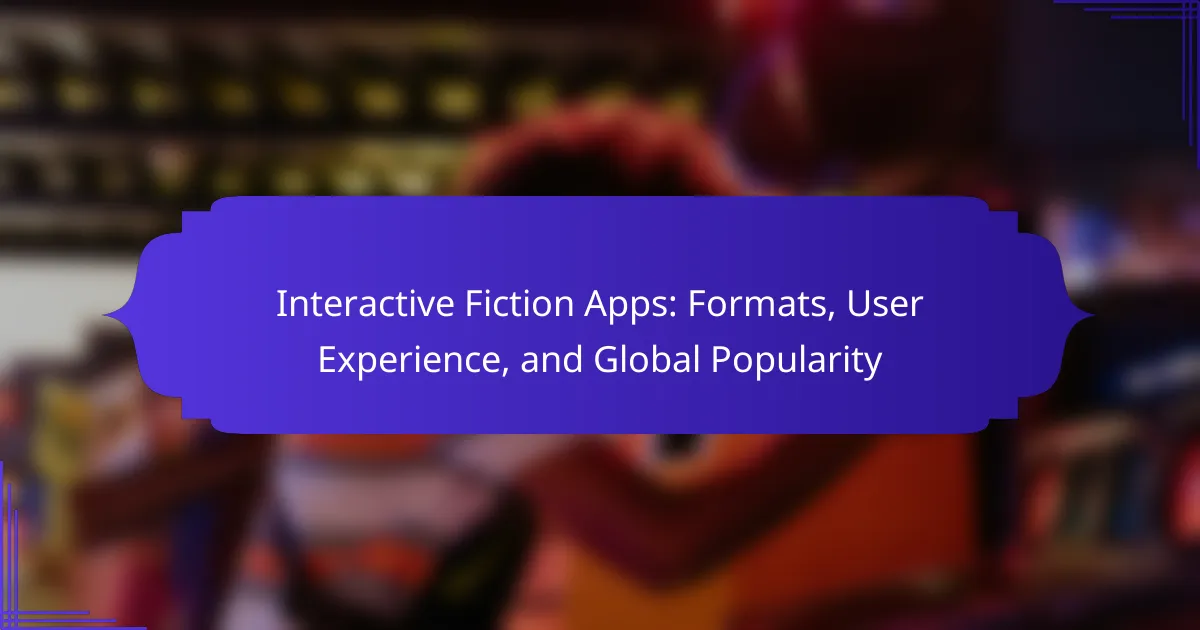Interactive fiction apps enhance storytelling by allowing users to actively engage with narratives. This article explores the various formats available, key user experience factors, and the cultural influences driving global popularity. It also addresses the challenges developers face in creating compelling content and the future trends shaping the industry.

How do interactive fiction apps enhance storytelling experiences?
Interactive fiction apps significantly enhance storytelling experiences by allowing users to engage actively with narratives. These apps provide immersive formats that combine text, choices, and multimedia elements, creating a unique user experience.
1. Interactivity: Users make choices that influence story outcomes, fostering deeper emotional connections.
2. Personalization: Stories adapt to user decisions, offering tailored experiences that enhance replayability.
3. Accessibility: Many apps are available on various platforms, reaching a global audience and promoting diverse storytelling.
4. Community: Users can share experiences and creations, building a collaborative storytelling environment.
5. Innovation: Developers experiment with formats, integrating gamification and multimedia to enrich narratives.
These attributes contribute to the growing popularity of interactive fiction apps worldwide.
What core features make interactive fiction apps engaging?
Interactive fiction apps engage users through immersive storytelling, interactivity, and user-driven choices. Core features include branching narratives that allow players to shape outcomes, rich character development that enhances emotional connection, and intuitive interfaces that facilitate seamless navigation. Additionally, the incorporation of multimedia elements, such as sound and visuals, elevates the overall user experience. Global popularity stems from the accessibility of these apps across platforms, catering to diverse audiences and fostering community engagement through shared experiences.
How do user choices impact narrative outcomes?
User choices significantly shape narrative outcomes in interactive fiction apps by influencing plot direction and character development. These applications enable users to make decisions that alter story trajectories, creating personalized experiences. The interactivity fosters engagement, as players feel their choices matter. Furthermore, diverse narrative branches cater to varying user preferences, enhancing global popularity. As a result, the unique attribute of user agency stands out, making each playthrough distinct and memorable.

Which formats of interactive fiction apps are most popular globally?
Interactive fiction apps are most popular in text-based, visual novel, and audio formats. Text-based formats allow immersive storytelling through written narratives, while visual novels combine graphics with branching plots. Audio formats enhance user experience through soundscapes and voice acting, appealing to diverse audiences.
What role do visual novels play in the interactive fiction landscape?
Visual novels significantly enhance the interactive fiction landscape by providing immersive storytelling experiences. They combine visual art, narrative depth, and user choice, engaging players in unique ways. This format allows for multiple endings based on player decisions, increasing replayability. Visual novels often include rich character development and emotional narratives, appealing to diverse audiences globally. Their popularity has surged, particularly in Japan, influencing game design and storytelling techniques in the broader interactive fiction genre.
How do text-based adventures differ from graphic interactive fiction?
Text-based adventures focus on narrative and player choice through written descriptions, while graphic interactive fiction combines visuals with text for enhanced storytelling. Text-based adventures rely on imagination, whereas graphic versions provide immediate visual context. This distinction influences user experience, engagement levels, and accessibility across diverse audiences.

What are the key user experience factors in interactive fiction apps?
Key user experience factors in interactive fiction apps include narrative depth, interactivity, user interface design, and community engagement. These elements enhance immersion and user satisfaction.
Narrative depth captivates users with compelling stories and character development. Interactivity allows users to make choices that influence outcomes, fostering a sense of agency. User interface design must be intuitive, enabling seamless navigation and interaction. Community engagement through forums or social features enhances the overall experience by connecting users with shared interests.
How does interface design affect user immersion?
Interface design significantly enhances user immersion in interactive fiction apps by creating an engaging and intuitive experience. Effective design elements, such as visual aesthetics, navigation simplicity, and responsive feedback, foster deeper emotional connections with narratives. Research indicates that immersive interfaces can increase user retention and satisfaction, leading to higher global popularity of these apps. For instance, well-structured layouts and interactive elements allow users to feel more present in the story, enhancing their overall experience.
What feedback mechanisms enhance player engagement?
Interactive fiction apps enhance player engagement through feedback mechanisms like real-time choices, adaptive storylines, and community-driven content. These elements encourage user interaction and investment in the narrative. Real-time choices allow players to see immediate consequences, while adaptive storylines respond to player decisions, making the experience feel personal. Community-driven content fosters collaboration, as players contribute to story development, enhancing immersion. Together, these mechanisms create a dynamic user experience that keeps players returning.

How does cultural context influence the popularity of interactive fiction apps?
Cultural context significantly shapes the popularity of interactive fiction apps by influencing narrative themes, user engagement, and marketing strategies. Different cultures prioritize unique storytelling styles and interactive elements, affecting user preferences. For instance, apps focusing on local folklore resonate more in regions with rich cultural histories. Additionally, cultural attitudes toward technology impact user adoption rates. In some cultures, mobile gaming is embraced as a social activity, enhancing collaborative storytelling experiences. As a result, developers often tailor content to align with regional tastes, maximizing appeal and engagement.
Which regions show unique trends in interactive fiction consumption?
Regions such as North America, Europe, and Asia show unique trends in interactive fiction consumption. North America leads in mobile app usage, while Europe favors narrative depth in text-based games. Asia demonstrates a rising interest in interactive storytelling through social media platforms. User preferences vary significantly, influenced by cultural contexts and technological access.
What themes resonate more in specific cultural narratives?
Interactive fiction apps often reflect cultural narratives through themes like identity, morality, and social dynamics. These themes resonate due to their universal relevance and adaptability across different cultures. For instance, narratives exploring personal identity engage users by allowing them to make choices that reflect their own experiences. Similarly, themes of morality challenge users to consider ethical dilemmas, fostering deeper engagement. Global popularity of these apps stems from their ability to incorporate local folklore and contemporary issues, making them relatable and appealing across various cultural contexts.

What challenges do developers face in creating interactive fiction apps?
Developers face several challenges in creating interactive fiction apps, including narrative complexity, user engagement, and platform compatibility.
Narrative complexity requires balancing branching storylines with coherent plot development. User engagement hinges on maintaining player interest through dynamic choices and compelling characters. Platform compatibility involves ensuring the app functions seamlessly across different devices and operating systems.
Additionally, monetization strategies can be difficult to implement effectively while preserving the user experience. Developers must also navigate the evolving landscape of user expectations and technological advancements.
How do monetization strategies impact app accessibility?
Monetization strategies can significantly impact app accessibility by influencing pricing models and user engagement. Free-to-play models often enhance accessibility, attracting a broader audience. In contrast, subscription-based apps may limit access to users willing to pay, potentially reducing overall user engagement.
Interactive fiction apps that utilize in-app purchases can provide a unique balance, allowing free access to core content while offering premium features. This model can enhance user experience by providing choices without overwhelming financial barriers.
Global popularity of these apps is often linked to their accessibility. Regions with lower disposable incomes may favor free models, leading to wider adoption. Thus, monetization strategies must consider user demographics to optimize reach and enhance accessibility.
What common technical limitations hinder user experience?
Common technical limitations that hinder user experience in interactive fiction apps include slow loading times, limited device compatibility, and inadequate user interface design. These issues can frustrate users and reduce engagement. For example, apps that do not optimize for various screen sizes may alienate users on different devices. Additionally, complex navigation can lead to confusion, detracting from the immersive experience that interactive fiction aims to provide.

What are the future trends for interactive fiction apps in 2025?
Interactive fiction apps will increasingly utilize immersive technologies, personalized storytelling, and community engagement in 2025. Enhanced user experiences will emerge through augmented reality and artificial intelligence, allowing for dynamic narratives. Global popularity will grow as localization and diverse themes attract wider audiences. Collaborative storytelling features will foster user interaction and creativity.
How will advancements in technology shape interactive storytelling?
Advancements in technology will significantly enhance interactive storytelling by improving user engagement and experience. Enhanced graphics, artificial intelligence, and immersive environments will allow users to influence narratives more dynamically.
Interactive fiction apps will benefit from advancements such as real-time decision-making, personalized storylines, and multi-platform accessibility. These features will increase global popularity, as users seek more immersive and tailored experiences.
The integration of virtual and augmented reality will create new formats, allowing users to interact with stories in unprecedented ways. This technological evolution will redefine traditional storytelling, making it more participatory and engaging.
As a result, the future of interactive storytelling will likely see a shift towards collaborative narratives, where users co-create stories, further enhancing their emotional connection and investment in the content.
What emerging genres are gaining traction in the interactive fiction market?
Interactive fiction is increasingly embracing genres like horror, sci-fi, and fantasy. These genres captivate audiences with immersive storytelling and interactive elements. The rise of narrative-driven experiences is evident in platforms like Twine and ChoiceScript, which empower creators to explore new themes. Additionally, the integration of multimedia elements enhances user engagement, making these genres more appealing globally.
What best practices can developers follow to optimize user engagement?
Developers can enhance user engagement in interactive fiction apps by focusing on storytelling, intuitive navigation, and community features. Engaging narratives keep users invested, while seamless interfaces enhance the user experience. Additionally, incorporating social elements fosters a sense of community, encouraging users to share their experiences.
1. Prioritize compelling narratives to captivate users.
2. Ensure intuitive navigation for a smooth user experience.
3. Integrate community features to promote interaction.
4. Regularly update content to maintain user interest.
5. Utilize feedback loops to improve app functionality.
